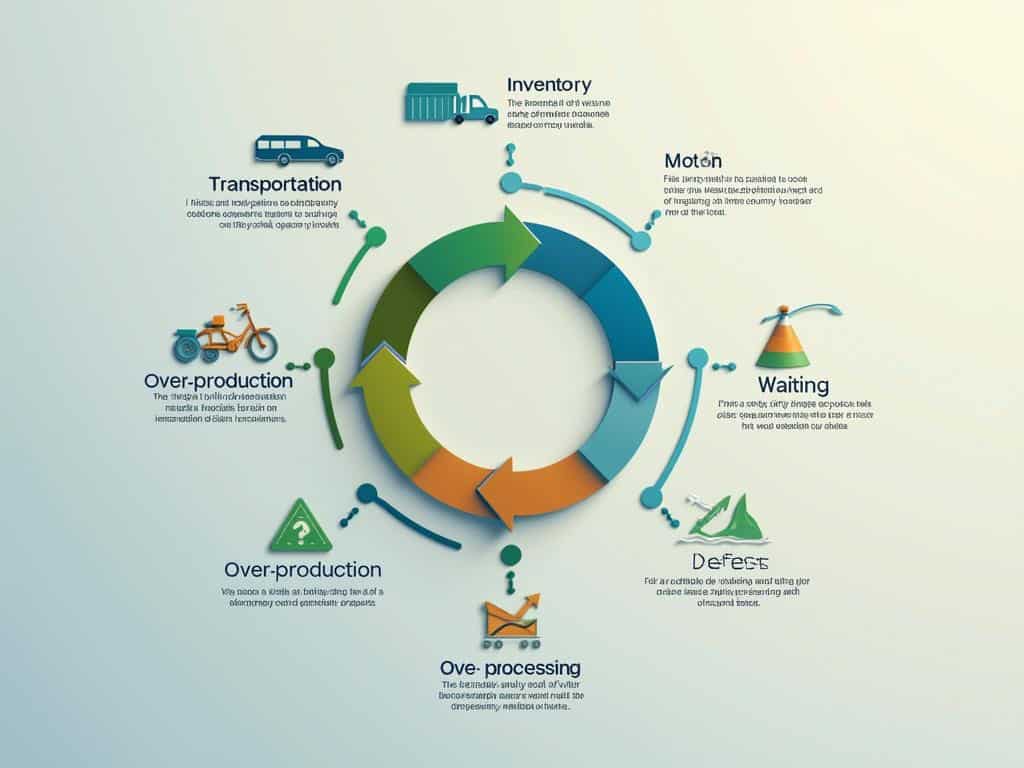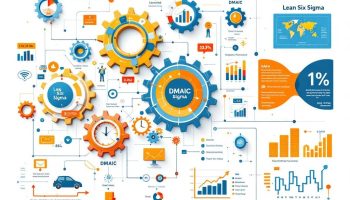
The 8 Lean Waste Principles
The 8 lean waste principles (TIMWOODS/DOWNTIME) offer a complete framework for spotting and removing inefficiencies in business operations. These principles target specific waste categories: transportation, inventory, motion, waiting, overproduction, over-processing, defects, and unused skills. Developed from the Toyota Production System, they aim to boost customer value by eliminating activities that don’t add value, helping companies streamline workflows, cut costs, and improve operational efficiency.
Key Takeaways
- The 8 lean waste principles can deliver up to 70-90% lead time reduction and 25-30% cost savings.
- Implementation typically results in an 80% defect reduction and 35% productivity increase.
- Tools like Just-In-Time, Kanban, and Value Stream Mapping support effective waste elimination.
- Lean principles drive both operational improvements and cultural transformation.
- Companies can achieve approximately 200% ROI within 12-18 months of comprehensive lean implementation.
“Embracing the 8 lean waste principles unlocks a pathway to operational excellence, where each step in eliminating inefficiencies not only boosts productivity and cuts costs but also cultivates a culture of continuous improvement. By systematically targeting waste—ranging from overproduction to unused skills—we empower organizations to deliver exceptional value to customers while achieving remarkable returns on investment.”
Understanding the Eight Lean Waste Principles
The 8 lean waste principles form a comprehensive framework derived from the Toyota Production System that helps businesses identify and eliminate inefficiencies. This methodology aims to maximize customer value by systematically removing activities that don’t add value to your products or services. Originating from the Japanese concept of muda (waste), these principles have revolutionized operational efficiency across industries.
You’ll often encounter these 8 lean waste principles referenced through the acronyms TIMWOODS or DOWNTIME, which represent the eight categories of waste that can drain your resources and reduce profitability.
The Eight Waste Categories Explained
Each of the 8 lean waste principles targets a specific type of inefficiency in your business processes:
- Transportation: Unnecessary movement of materials, products, or information between processes creates delays and increases costs.
- Inventory: Excess raw materials or work-in-progress ties up capital and creates storage challenges.
- Motion: Unnecessary physical movements by workers or equipment wastes time and energy.
- Waiting: Idle time when people, materials or information wait for the next process step creates bottlenecks.
- Overproduction: Manufacturing more than immediate customer needs leads to inventory buildup.
- Over-Processing: Performing unnecessary steps beyond customer requirements wastes resources.
- Defects: Errors requiring rework or scrapping products damage profitability and reputation.
- Skills (or Non-utilized Talent): Failing to leverage employee creativity and potential limits innovation.
The impact of implementing these 8 lean waste principles can be transformative. Companies typically see lead time reductions of 70-90%, manufacturing cost savings of 25-30%, and defect reductions of approximately 80%. Your labor productivity can increase by 35%, with lean initiatives delivering ROI of approximately 200% within 12-18 months.
You can leverage several strategic tools to apply the 8 lean waste principles effectively:
- Just-In-Time production alignment
- Kanban visual scheduling system
- 5S workplace organization methodology
- Value Stream Mapping
- Software integration for operational optimization
Implementing the 8 lean waste principles creates both operational and cultural transformation. You’ll experience streamlined workflows, enhanced employee engagement, and develop a continuous improvement culture (Kaizen). This approach increases your organizational adaptability while building competitive advantage through efficiency.
To begin implementing these principles, conduct a comprehensive waste assessment, train your team in Lean methodologies, and implement targeted lean thinking principles for waste reduction. Your focus should remain on continuous monitoring and fostering an organizational culture that values efficiency and innovation.
Organizations that implement lean principles can experience improvements of up to 30% in productivity and 25% in costs, thereby enhancing their competitive edge in the market.
hbr.org
Impact of 8 Lean Waste Principles
Implementing these 8 lean waste principles delivers significant measurable benefits:
| Improvement Area | Typical Impact |
|---|---|
| Lead time reduction | 70-90% improvement |
| Manufacturing costs | 25-30% decrease |
| Defect reduction | 80% improvement |
| Labor productivity | 35% enhancement |
| Lean initiative ROI | 200% within 12-18 months |
| Energy consumption | 10-25% reduction |
You can leverage strategic tools to reduce these 8 lean waste principles, including Just-In-Time production, Kanban scheduling, 5S workplace organization, and value stream mapping. These approaches support both operational and cultural transformation, creating streamlined workflows, enhanced employee engagement, and a culture of continuous improvement.
To implement the 8 lean waste principles effectively, start with a comprehensive waste assessment, train your employees in lean methodologies, and develop targeted reduction strategies. This systematic approach to waste elimination will drive efficiency and value throughout your business operations.

Quantitative Impact of Waste Elimination
Eliminating waste through the 8 lean waste principles delivers remarkable financial and operational benefits. You’ll see dramatic improvements across multiple performance indicators when implementing these principles effectively. Companies that fully embrace lean methodologies consistently report transformative results.
Lead time reduction stands out as one of the most significant impacts, with 70-90% improvement possible when transportation and waiting wastes are addressed. By implementing the 8 lean waste principles, your manufacturing costs can decrease by 25-30%, directly improving your bottom line. Defect reduction reaches approximately 80% improvement when quality issues are systematically eliminated through lean practices.
Labor productivity increases by around 35% when motion waste and skills underutilization are properly addressed. The return on investment for comprehensive lean initiatives averages approximately 200% within 12-18 months, making the 8 lean waste principles a high-value business strategy. Environmental benefits include 10-25% energy consumption reduction, supporting both cost savings and sustainability goals.
Transformation Through Strategic Lean Tools
You can maximize these quantitative benefits by implementing specific tools designed around the 8 lean waste principles:
- Just-In-Time (JIT) production aligns manufacturing with actual demand, reducing inventory waste
- Kanban visual systems minimize waiting time between process steps
- 5S workplace organization significantly reduces motion waste
- Value Stream Mapping identifies non-value-adding activities for elimination
- Software integration optimizes data flow and reduces information transportation waste
These approaches work together to drive continuous improvement in your operations. The 8 lean waste principles provide a structured framework for identifying opportunities that might otherwise remain hidden in your processes.
When applied comprehensively, these principles transform not just metrics but entire organizational cultures. You’ll find employees become more engaged in improvement activities as they see the impact of waste elimination. This cultural shift creates a leadership opportunity to drive ongoing excellence across all operations.
The quantitative benefits of the 8 lean waste principles demonstrate why lean methodologies remain central to operational excellence strategies. By systematically targeting each waste category, you create a multiplier effect that enhances overall organizational performance beyond what isolated improvement efforts can achieve.

Strategic Lean Waste Reduction Tools
Eliminating waste is central to operational excellence. The 8 lean waste principles provide a structured approach to identify and remove inefficiencies that drain resources and diminish value. These principles, originated from Toyota’s Production System, transform how you manage processes and deliver customer value.
Essential Tools for Waste Elimination
You’ll need practical tools to apply the 8 lean waste principles effectively. Here are the key strategic approaches that drive successful implementation:
| Tool | Primary Purpose | Waste Categories Addressed |
|---|---|---|
| Just-In-Time (JIT) | Align production with demand | Inventory, Overproduction, Waiting |
| Kanban System | Visual scheduling and flow control | Inventory, Waiting, Transportation |
| 5S Methodology | Workplace organization and standardization | Motion, Waiting, Transportation |
| Value Stream Mapping | Visualize process flows to identify waste | All 8 waste principles |
| Software Integration | Optimize data flow and operations | Transportation, Waiting, Skills |
Implementing these tools creates a continuous improvement culture that transforms your operations. Companies that embrace the 8 lean waste principles don’t just reduce costs – they gain competitive advantage through enhanced quality, faster delivery, and improved employee engagement.
When conducting process improvement initiatives, the 8 lean waste principles provide a comprehensive framework to evaluate every aspect of your operations. This systematic approach ensures you’re addressing root causes rather than symptoms, creating sustainable efficiency gains.
Implementing Lean methodologies can yield cost reductions of 25–30% and lead time reductions of 70–90%, showcasing significant improvements in operational efficiency.
hbr.org
Operational and Cultural Transformation
Implementing the 8 lean waste principles transforms both operations and organizational culture. These principles help you systematically identify and eliminate inefficiencies, creating a streamlined workflow that delivers maximum value to customers. The 8 lean waste principles (often remembered through the acronym TIMWOODS) provide a framework for recognizing where value is being lost in your processes.
When you apply lean thinking principles across your organization, operational workflows become dramatically more efficient. Unnecessary steps are eliminated, allowing teams to focus exclusively on value-adding activities. Companies that successfully implement these 8 lean waste principles typically report lead time reductions of 70-90% and manufacturing cost savings of 25-30%.
Cultural Benefits of Lean Waste Elimination
Beyond operational improvements, the 8 lean waste principles foster significant cultural changes:
- Enhanced employee engagement: When staff understand the 8 lean waste principles, they become active participants in identifying improvement opportunities. This empowerment increases job satisfaction and ownership.
- Continuous improvement mindset: The 8 lean waste principles establish Kaizen (continuous improvement) as a daily practice rather than an occasional initiative.
- Increased adaptability: Organizations that eliminate waste through the 8 lean waste principles develop greater flexibility to respond to market changes.
- Innovation culture: Removing waste creates space for creativity and process improvement systems that drive innovation.
To maximize these transformations, you’ll need to integrate lean methodologies with project integration management practices. This combination ensures waste reduction efforts align with broader organizational goals.
| Operational Impact | Cultural Impact |
|---|---|
| 70-90% lead time reduction | Empowered workforce |
| 25-30% cost savings | Problem-solving mentality |
| 80% defect reduction | Data-driven decision making |
| 35% productivity increase | Cross-functional collaboration |
| 200% ROI within 18 months | Continuous improvement mindset |
Your organization’s competitive advantage increasingly depends on applying these 8 lean waste principles. By eliminating transportation, inventory, motion, waiting, overproduction, over-processing, defects, and skills waste, you’ll create an efficient operation powered by an engaged workforce committed to delivering maximum customer value.
Implementing Lean Waste Principles: Next Steps
You’re ready to transform your business using the 8 lean waste principles. To successfully implement these powerful efficiency drivers, you’ll need a structured approach that combines assessment, training, and continuous improvement.
Start by conducting a comprehensive waste assessment across your operations. Identify where the 8 lean waste principles (Transportation, Inventory, Motion, Waiting, Overproduction, Over-Processing, Defects, and Skills) are impacting your business. Use value stream mapping to visualize your current processes and highlight non-value-adding activities. This critical first step reveals opportunities where you can achieve the impressive 25-30% cost savings typical of successful lean implementations.
Training your team on the 8 lean waste principles is essential for sustainable results. Ensure every employee understands how to identify and eliminate waste in their daily work. Consider implementing the 5S methodology (Sort, Set in order, Shine, Standardize, Sustain) as a foundation for workplace organization. This practical approach has helped organizations achieve up to 35% productivity improvements through better workspace efficiency.
Next, develop targeted waste reduction strategies for each identified area. Prioritize high-impact opportunities that align with your business goals. For instance, continuous improvement efforts focused on defect reduction can yield approximately 80% fewer quality issues, significantly enhancing customer satisfaction.
Monitor progress through meaningful metrics that track the impact of your waste reduction initiatives. Establish baseline measurements before implementation and regularly evaluate performance against these benchmarks. This data-driven approach ensures you can demonstrate the ROI of your lean initiatives, which typically reaches 200% within 12-18 months.
Building a Culture of Lean Thinking
Creating a culture that embraces the 8 lean waste principles requires consistent leadership commitment. Encourage employees to identify waste in their work areas and empower them to implement improvements. This lean thinking approach leverages previously unused talent—one of the eight wastes—and can reduce lead times by an impressive 70-90%.
Implement visual management tools to make waste visible and progress transparent. Kanban boards, performance dashboards, and regular team huddles help maintain focus on waste elimination goals. These visual cues reinforce the importance of the 8 lean waste principles in daily operations.
Remember that implementing lean waste principles isn’t a one-time project but an ongoing journey. Establish regular review cycles to refine your approach and address new sources of waste as they emerge. This commitment to continuous improvement will drive sustained efficiency gains and competitive advantage through operational excellence.






